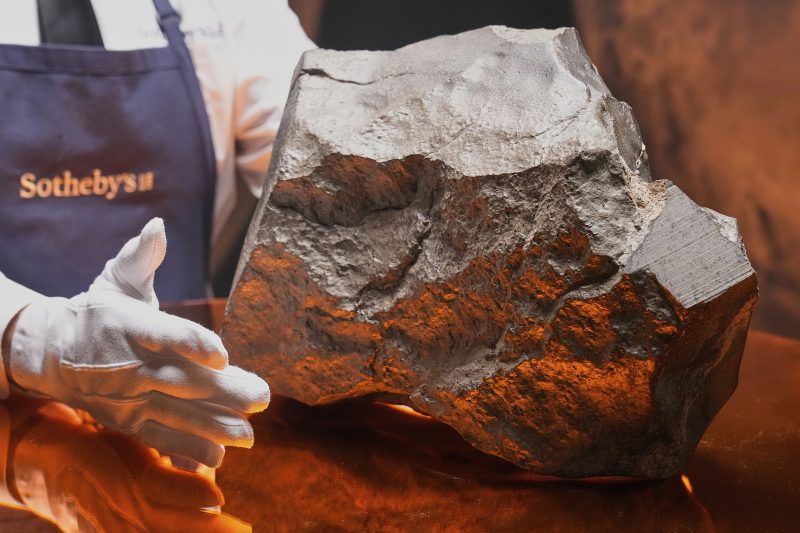A Record-Breaking Sale of a Martian Meteorite and a Dinosaur Skeleton
A remarkable event took place at an auction in New York, where the largest piece of Mars ever discovered on Earth was sold for over $5 million. This meteorite, named NWA 16788, was just one of several high-profile items that captured attention during the auction, which also featured a juvenile dinosaur skeleton that fetched more than $30 million.
The Martian meteorite, weighing 54 pounds, was found in the Sahara Desert in Niger by a meteorite hunter in November 2023. It is believed to have been ejected from the surface of Mars due to a massive asteroid impact and traveled approximately 140 million miles before landing on Earth. Before the auction, its estimated value ranged between $2 million and $4 million.
The final sale price of the meteorite, including various fees and costs, reached about $5.3 million. Although the identity of the buyer remains undisclosed, the bidding process was notable for its slower pace compared to other items in the auction. The auctioneer had to encourage more bids, adjusting the bid increments from $200,000 to $300,000 down to $100,000 after the offers reached $4 million. Two advance bids of $1.9 million and $2 million were submitted prior to the live auction.
NWA 16788 is not only significant for its size but also for its rarity. It measures nearly 15 inches by 11 inches by 6 inches and is about 70% larger than the next largest Martian meteorite found on Earth. According to Sotheby’s, it represents nearly 7% of all Martian material currently on the planet. There are only 400 Martian meteorites among the more than 77,000 officially recognized meteorites found on Earth.
“This Martian meteorite is the largest piece of Mars we have ever found by a long shot,” said Cassandra Hatton, vice chairman for science and natural history at Sotheby’s. “So it’s more than double the size of what we previously thought was the largest piece of Mars.”
Testing suggested that the meteorite was likely blasted off the surface of Mars in recent years, though the exact timing remains uncertain. A specialized lab examined a small sample and confirmed it was from Mars, comparing it with the chemical composition of Martian meteorites discovered during the Viking space probe missions in 1976.
The meteorite is classified as an “olivine-microgabbroic shergottite,” a type of rock formed from the slow cooling of Martian magma. It features a course-grained texture with minerals like pyroxene and olivine. Its glassy surface is likely the result of intense heat during its descent through Earth’s atmosphere.
Prior to the auction, the meteorite was on display at the Italian Space Agency in Rome. However, the owner’s identity was not disclosed.
A Dinosaur Skeleton That Stole the Spotlight
Alongside the Martian meteorite, another extraordinary item was the juvenile Ceratosaurus nasicornis dinosaur skeleton. Bidding for this fossil began with a high advance bid of $6 million, and the final sale price reached $30.5 million, including fees and costs. The initial estimate for the skeleton was between $4 million and $6 million.
The skeleton, which stands over 6 feet tall and is nearly 11 feet long, was assembled from nearly 140 fossil bones, with some sculpted materials used to recreate the full structure. It was mounted for exhibition and acquired last year by Fossilogic, a Utah-based fossil preparation and mounting company.
Parts of the skeleton were discovered in 1996 near Laramie, Wyoming, at the Bone Cabin Quarry, a site known for its rich deposits of dinosaur bones. The Ceratosaurus is believed to date back to the late Jurassic period, around 150 million years ago. These dinosaurs were bipedal with short arms, resembling smaller versions of the Tyrannosaurus rex. They could grow up to 25 feet long, while their more famous cousin, the T. rex, could reach lengths of up to 40 feet.
Other Highlights from the Auction
The auction, part of Sotheby’s Geek Week 2025, featured 122 items, including other meteorites, fossils, and gem-quality minerals. The event showcased a wide range of rare and valuable objects, drawing attention from collectors and enthusiasts alike.
The sale of the Martian meteorite and the dinosaur skeleton highlighted the growing interest in unique geological and paleontological artifacts. These items not only offer scientific value but also serve as tangible connections to the distant past, whether from Mars or ancient Earth.
